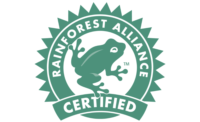

Rutter’s Farm Stores may have started as an effort to sell quarts of milk from a horse drawn wagon in 1921, but with smart phone apps, computer-run ordering kiosks and fl at-screen TVs in their stores, the convenience store chain is anything but old-fashioned.
The company’s stores, most of which are also gas stations, are scattered throughout Pennsylvania and have become a model for mixing traditional family values with the latest and greatest technology trends. The average store is just 11 years old and about 5,300 sq. ft. - or about 50% more than the size of an average convenience store size of about 3,500 sq. ft.
“We’re a grocery store, and we’re a fast-food restaurant, and we’re a gas station, and we’re a little casino that sells lottery, and we’re a little bank that sells money orders,” explains Scott Hartman, president and CEO. “We’re so many different things all under one roof.”
One of the problems gas stations have had to face, though is the increase in customers paying at the pump, which decreases the need to go inside and peruse all those features.
Robert Perkins, vice president of marketing, says the company uses signage at the pumps to lure them inside, and also feature free ATMs, and promotional gas offers as well as expanded food offerings. Selling candy conveniently Once they get the customer through the door, not only are they greeted with the latest gadgets, they’re also faced with a 12-foot candy aisle.
And, footprint at the transaction counter. There, they focus on three items - energy shots, candy and lighters.
“We are very traditional,” Perkins says. “[But] we’re always looking for new items, and king-size and theater boxes have been a big area for us most recently.”
Hartman said there are obvious benefits to selling a king-size candy bar versus a regular-sized bar.
“Because we’re going to make more gross profit dollars,” he explains. “To retailers, it’s not percentages that’s important, it’s dollars or pennies. [King size] will make more pennies than selling a regular-size bar.”
He admits it’s a challenge to sell the king-size candy, though. One way they try to entice customers are with “combo offers.”
“When somebody is buying a candy bar, what else goes with it?” Hartman says. “You can better design promotional activity and marketing and you make them offers.”
Applying the Apps
With the Rutter’s smart phones applications (apps), customers can get those promotional offers right on their phones. Hartman says a company from Canada pitched the idea for the app a little more than two years ago, and he immediately saw the potential.
“I said, ‘Oh, wow, you guys are good,” he recalls. ‘So we just signed on with them.”
Now, customers can use the app to find a store and get directions; check real-time gas prices; scan store features such as fuel types and WiFi; and receive promotional alerts.
Hartman won’t disclose exactly how many customers have signed up for the app, but he did say there are “thousands and thousands of users.”
“It’s amazing the number of people who are signing up everyday on those,” Hart man says. “We get a lot e-mails from people saying, ‘Your app is the coolest I’ve got.’”
The concept goes beyond offering customers convenience though.
“The point is it’s giving them opportunities to be reminded about our brand, be reminded about our offers,” Hartman explains.
He predicts that the next frontier is allowing customers to pay with their phones. However, the technology is hard to navigate for a gas station because gas is flammable. That means the company can’t install anything near the pumps that could agitate that.
“I do believe it’s coming... Starbucks is doing it now,” he says. “The difference is that so many of our transactions are at a gasoline pump and trying to get consumers to use their phone at gasoline pump has a lot of industry hurdles, [but] we will be using it inside, I would say in the next year or two.”
It’s a natural evolution, he explains.
“The phone is becoming the customer’s electronic wallet,” Hartman says. “The younger folks don’t think twice about using plastic, and the phone will be the better, more efficient way.”
Beyond the phone
One way Rutter’s has already introduced efficiency at the counter is with it’s computer-ordering kiosks, which allow customers to place a food order without ever talking to a human.
Hartman says one of the main advantages is the elimination of human error.
“And, they provide a lot of options that are hard to do with a human involved, in terms of combinations,” he explains. “It’s very easy to customize your order. To say, ‘I don’t want ketchup, and I don’t want pickle... the computer’s quite friendly. It’ll even suggest things to you.”
With the rate the technology has evolved, Hartman says both young and old have embraced the ordering kiosks, especially as other industries incorporate technology, such as airports that use computer check-in systems.
Rutter’s has even received technology awards and has long been involved in industry technology, but Hartman’s quick to point out that it’s not the end all.
“Just getting the latest gadget isn’t the way to sell stuff necessarily,” he explains. “I’m a third-generation of a family business, so I was just sort of trained that you have to keep changing and staying current with your customers.”
‘Greener’ stores
Another of those changes that Hartman has pushed his stores on is being “green.”
Rutter’s was the first retailer to do voluntary recycling in their stores. Now the company boasts of white roofs on their stores (cuts down on cooling), and they’ve installed a computer system to monitor energy use.
Next on Rutter’s to-do list is installing sky lights, which bring in natural light and allows the lights in the store to be shut off.
“We learned a lot about going green from trips overseas. I take my management team... to Ireland and Portugal,” Hartman explains. “As business people we just have to embrace the idea that we can take care of the environment better than we have in the past.”
He adds that a number of the green initiatives also have the upside of having a return on investment and also appeal to customers.
“I can tell you we got a lot of positive feedback,” Hartman explains. “Particular younger people.”
Hartman says he tries his best to keep Rutter’s at the forefront, but he admits it’s not right for everyone.
“If you don’t have a commitment from the top, absolutely don’t do it, because a lot of the stuff that we’re doing... just needs a commitment and a strategy,” he says. “It’s a cultural thing within our company. Do I like gadgets? Sure. I have more laptops than anybody [but] it’s more than that, it’s how you interact with the customers.”
If he can keep that balanced attitude, it’s likely the customers will have no reply when faced with the Rutter’s tag line, “Why go anywhere else?”






